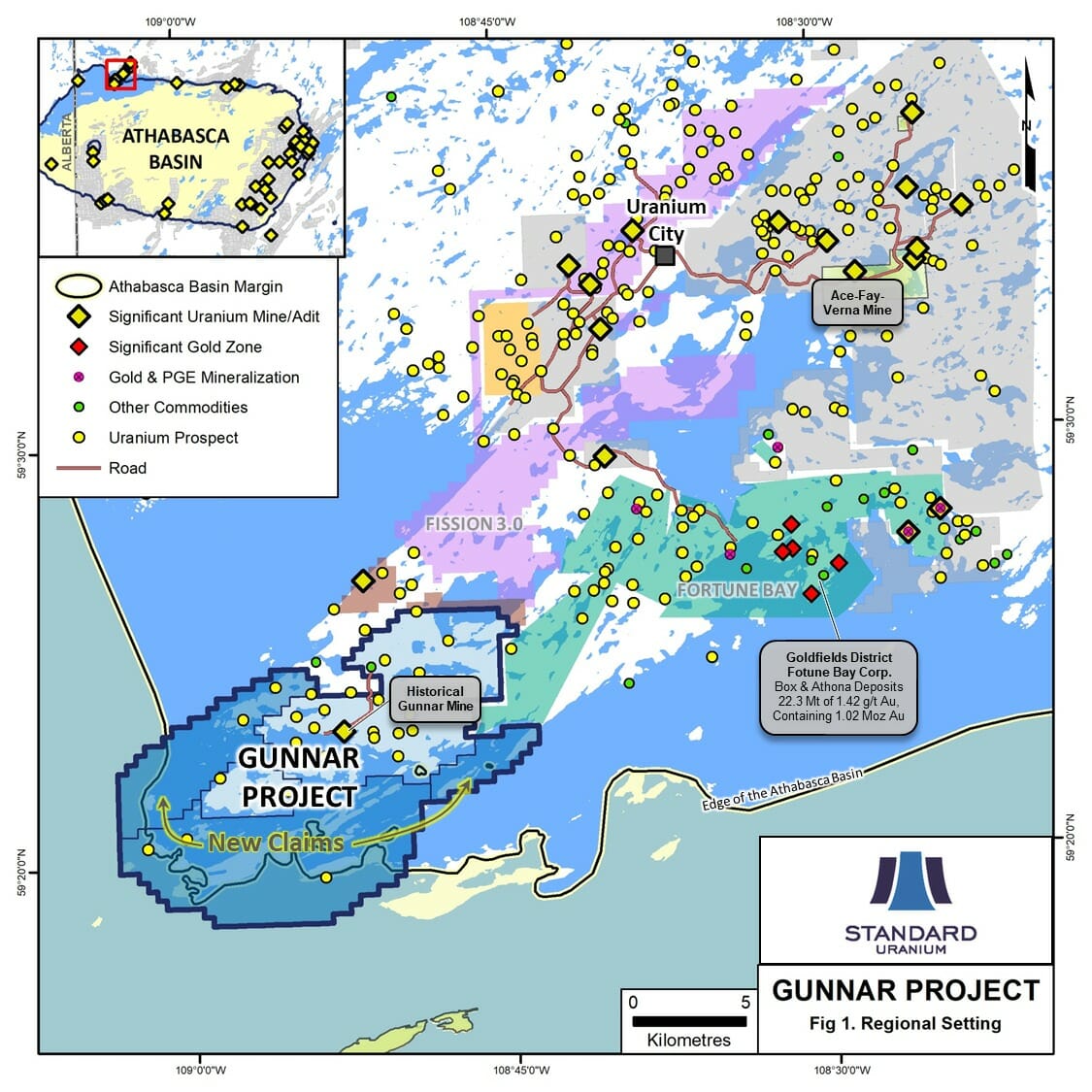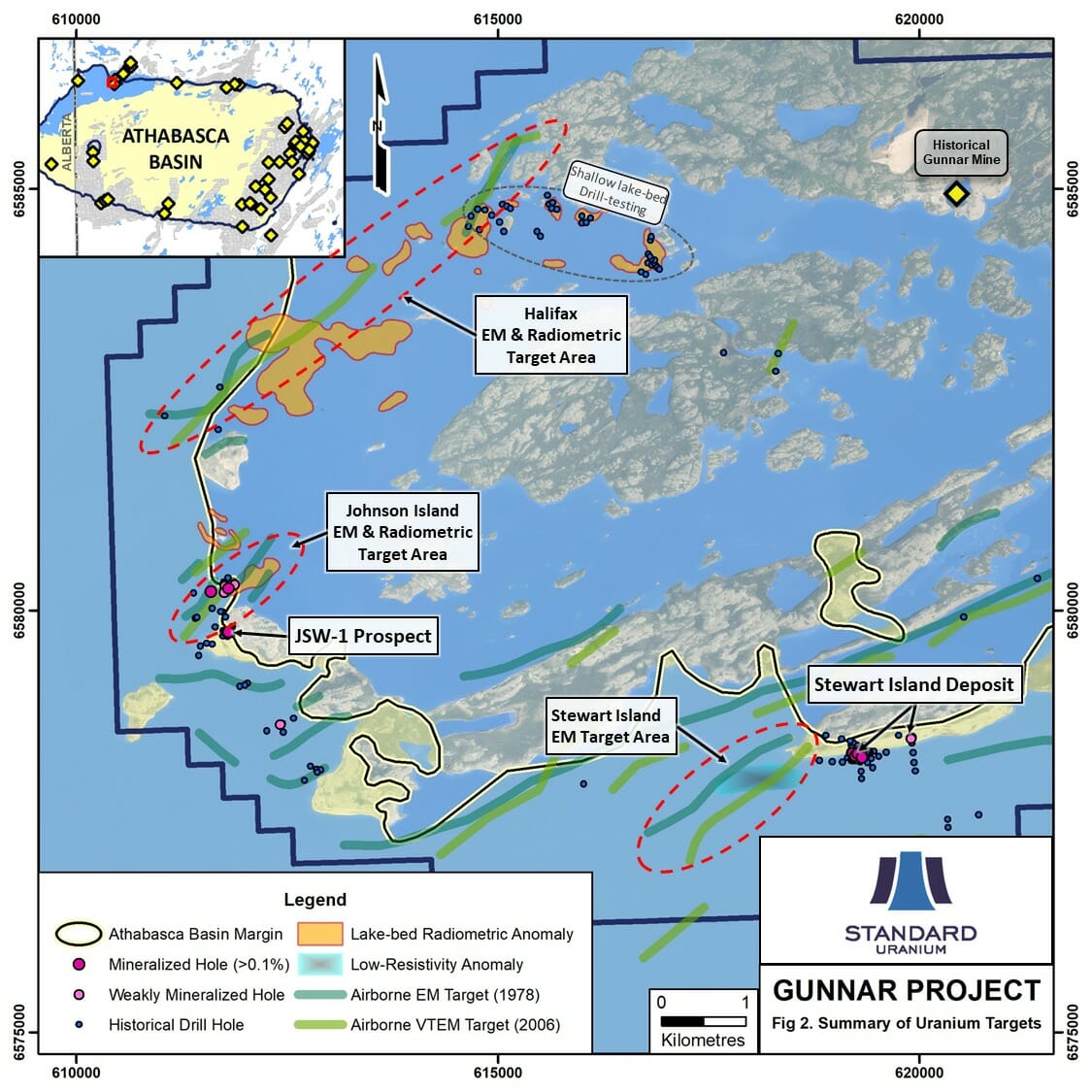VANCOUVER, British Columbia, July 15, 2020 — Standard Uranium Ltd. (“Standard Uranium” or the “Company”) (TSX-V: STND) is pleased to announce that it has acquired, through staking, three new claims adjacent to the Company’s existing claim package in the Northern Athabasca Basin (the “Gunnar Project”), and the Gunnar Project now totals 15,770 Hectares. The new claims contain unconformity-and basement-hosted (“unconformity-style”) uranium targets in three areas that were historically explored by the predecessors of Cameco (Eldorado Nuclear and SMDC) between 1976 and 1981 and more recently by Canalaska between 2005 and 2010. The Gunnar Project is located at the south end of the prolific Beaverlodge Uranium District, where uranium was mined between 1953 and 1982.
In addition to the uranium potential of the Gunnar Project, the Company believes that there is significant gold and PGE potential. The Goldfields District is currently being advanced by Fortune Bay Corp., with the Box and Athona deposits, that have a historical resource of 22,333,045 tonnes at an average grade of 1.42 g/t Au (1,020,000 ounces of gold) (*). The Goldfields District was Saskatchewan’s first gold mining camp and operated starting in 1934 until the Box Mine closed in 1942 due to a work force shortage with the onset of World War II. Additionally, several gold and PGE occurrences were discovered in the Goldfields District (Figure 1). Many parts of the Beaverlodge Uranium District, including the Company’s Gunnar Project, share the same Murmac Bay Group basement geology as the Goldfields District, but little-to-no gold exploration has occurred.
The new claims of the Gunnar Project have many attributes that are favourable for high-grade unconformity-style uranium mineralization. The key geological factors include:
- Uranium enriched bedrock (source of uranium)
The Beaverlodge District is host to numerous zones of uranium mineralization that pre-date the formation of the Athabasca Basin. Additionally, the granitic basement rocks in the Beaverlodge District have an elevated background content of uranium.
- Re-activated structures in the basement (plumbing system for fluids)
The Beaverlodge area is host to several northeast-trending structures including the Black Bay and St Louis Faults. Uranium deposits in the Beaverlodge District are related to up to six to periods of uranium mineralization associated with multistage deformation during Proterozoic tectonism. One of these mineralization events is equivalent in time to the generally accepted timeframe for unconformity-style mineralization in the Athabasca Basin.
- Athabasca Sandstone cover (Fluid Transport)
The southernmost portion of the Gunnar Project are covered by sandstones of the Athabasca Basin. The Athabasca Group is an important component of the exploration model as it allows for the presence of uranium mineralization at the contact between the Athabasca Group and basement unconformity, or immediately below it, as is the case for most unconformity-style uranium deposits elsewhere in the Athabasca Basin.

- Favourable basement lithologies (uranium traps)
Where tested by drilling on the Gunnar Project, the electromagnetic (EM) conductors correspond to altered chlorite, graphite and sulphide bearing metasediments, and in some areas are uranium-bearing. Additionally, the Gunnar Project is located in an area where basement rocks of Quartzite are next to metapelites (+/- graphite) and metavolcanics (+/- sulphide). This theoretically provides the competency contrast necessary to localise strain along the fault systems, as is the case in several unconformity-style uranium deposits elsewhere in the Athabasca Basin.
The new claims are host to three main target areas, and each of them are summarized herein.
- Stewart Island Target
At the south end of Steward Island is a small uranium deposit that was defined during exploration between 1960 and 1969. A small historical resource of 2,561 tons averaging 0.476% U3O8 was defined in three separate zones (*). This “perched” mineralization is hosted in a single Athabasca Group sandstone horizon. A historical surface sample across the surface exposure returned 1.05% U3O8 over 2.6 m. Historical drill hole N-2 drilled at -30° intersected 0.9% U3O8 over 5.49 m. Radiogenic age-dating has given the uranium mineralization at Stewart Island a date of 318 Ma. This is considerably more recent than the generally accepted main stage of mineralization for most uranium deposits in the Athabasca Basin of 1350-1250 Ma. The age of mineralization at Stewart Island is coincident with other re-mobilization events in other parts of the Athabasca Basin. A compilation of historical work in the area has defined a high-priority electromagnetic target, thought to be a favourable host-rock for traditional unconformity-style uranium mineralization, located approximately 1-km west of the current Stewart Island sandstone-hosted mineralization (Figure 2). The Company interprets that the mineralization that constitutes the historically defined uranium mineralization at Stewart Island is a re-mobilized portion of a larger, as-to-be discovered classic unconformity-style mineralization nearby. Other classic unconformity-style uranium deposits in the Athabasca Basin contain lower-grade “perched” uranium mineralization related to larger and higher-grade deposits of uranium at the unconformity or in the basement (Midwest, Cigar Lake, Dawn Lake, Shea Creek for example). The exploration model is that the conductive targets defined by two airborne EM surveys and a recent ground IP survey are related to a potential main mineralized zone.
- Johnston Island Target
At the north-west end of Johnston island is the historical JNW-1 prospect. This Athabasca sandstone hosted mineralization has been sampled on the surface with results of 0.43% U3O8 over 4.2 m and 0.25% U3O8 over 1.5 m. The immediate area of the JNW-1 prospect was drill-tested with 14 drillholes and only two were mineralized (DDH-3: 0.25% U3O8 over 1m and DDH-5: 0.163% U3O8 over 1 m). Subsequent historical drilling about 500 metres to the north of this prospect intersected minor uranium mineralization within several drill holes that intercepted strongly altered and brecciated, chlorite, sulphide and graphite bearing metasediments below the Athabasca sandstone. The best hole of the area, LAO-1, contains 0.10% U3O8 over 1 metre. Follow-up drilling of one hole by Canalaska in 2008 reveal strong hydrothermal alteration with gold mineralization of 0.4 g/t Au over 15.9 metres in systematic chip sampling. (**) The gold mineralization can be attributed to either a strong uranium-related hydrothermal alteration event, or is a distinct gold target, itself. Compilation of this work has revealed un-tested targets in either direction of the 1.6 km strike length of the EM Targets, and there is a large lake-bed radiometric anomaly that continues for 600 metres in the northeast direction (Figure 2).
- Halifax Island Target
Compilation of historical exploration data has revealed a series of conductive horizons, drill-tested at the south-west end, that are confirmed to be related to chlorite, sulphide and graphite bearing metasediments. They correspond with lake-bed radiometric survey anomalies along a roughly 5-kilometre-long trend to the northeast (Figure 2). In 1978, SMDC drilled 39 shallow drill holes to test the lake-bed radioactive anomalies before the knowledge of the conductive trends to the west and south. These holes averaged only 18 metres in length, and only about 10 metres of basement was penetrated. The Company believes that there is substantial un-tested exploration potential for classic unconformity-style uranium mineralization along this north-east trending structure.
*The historical mineral resource estimates listed above either use categories that are not compliant with National Instrument 43-101 – Standards of Disclosure for Mineral Projects (“NI 43-101”) and cannot be compared to NI 43-101 categories, or are not current estimates as prescribed by NI 43-101, and therefore should not be relied upon. A qualified person has not done sufficient work to classify the estimates as current resources and Standard is not treating the estimates as a current resource estimate. However, the estimates are relevant to guiding the Company’s exploration plans and provide geological information regarding the type of mineralization that could be present in the Gunnar Project area.
**Systematic sampling is described in the assessment report as “Samples taken each metre (18 half-cores of 5 cm in sandstone and per lithology in basement portion of each hole).
Neil McCallum, VP Exploration, states: “The Gunnar Project represents another addition of a high-quality uranium exploration asset to our portfolio, thereby bolstering Standard Uranium’s position as a leader in exploration for high-grade uranium mineralization in the Athabasca Basin. We look forward to advancing all of our projects as we seek to add value to our shareholders through discovery.”

The scientific and technical information contained in this news release has been reviewed and approved by Neil McCallum, VP Exploration and is a “Qualified Person” as defined in NI 43-101.
About Standard Uranium (TSX-V: STND)
We find the fuel to power a clean energy future
Standard Uranium is a mineral resource exploration company based in Vancouver, British Columbia. Since its establishment, Standard Uranium has focused on the identification and development of prospective exploration stage uranium projects in the Athabasca Basin in Saskatchewan, Canada. Standard Uranium’s Davidson River Project, in the southwest part of the Athabasca Basin, Saskatchewan, is comprised of 21 mineral claims over 25,886 hectares. The Davidson River Project is highly prospective for basement hosted uranium deposits yet remains untested by drilling despite its location along-trend from recent high-grade uranium discoveries. A copy of the 43-101 Technical Report that summarizes the exploration on the project is available for review under Standard Uranium’s SEDAR issuer profile (www.sedar.com).
For further information contact:
Jon Bey, President, Chief Executive Officer, and Chairman
550 Denman Street, Suite 200
Vancouver, BC V6G 3H1
Tel: 1 (604) 375-4488
E-mail: info@standarduranium.ca
Cautionary Statement Regarding Forward-Looking Statements
This news release includes certain information and statements about management’s view of future events, expectations, plans and prospects that constitute “forward looking statements”, which are not composed of historical facts. Forward-looking statements may be identified by such terms as “believes”, “anticipates”, “intends”, “expects”, “estimates”, “may”, “could”, “would”, “will”, or “plan”, and similar expressions. Specifically, forward looking statements in this news release include, without limitation, statements regarding: the uranium, gold and PGE potential of the Gunnar Project; the timing and content of upcoming work programs, geological interpretations, receipt of property titles, potential mineral recovery processes, and estimates of market conditions. These statements involve known and unknown risks, uncertainties, and other factors that may cause actual results or events, performance, or achievements of the Company to differ materially from those anticipated or implied in such forward-looking statements. The Company believes that the expectations reflected in these forward-looking statements are reasonable, but there can be no assurance that actual results will meet management’s expectations. In formulating the forward-looking statements contained herein, management has assumed that business and economic conditions affecting the Company will continue substantially in the ordinary course and will be favourable to the Company. Factors that may cause actual results to differ materially from those anticipated by these forward looking statements include: changes in equity markets; the Company’s ability to raise additional capital if and when necessary; and other factors as described in detail in the Company’s annual information form dated May 2, 2020 other public filings, all of which may be viewed on SEDAR (www.sedar.com). Given these risks and uncertainties, readers are cautioned not to place undue reliance on such forward-looking statements and information, which are qualified in their entirety by this cautionary statement. Except as required by law, the Company disclaims any intention and assumes no obligation to update or revise any forward looking statements to reflect actual results, whether as a result of new information, future events, changes in assumptions, changes in factors affecting such forward looking statements or otherwise.
Neither TSX-V nor its Regulation Services Provider (as that term is defined in the policies of the TSX-V) accepts responsibility for the adequacy or accuracy of this release.
